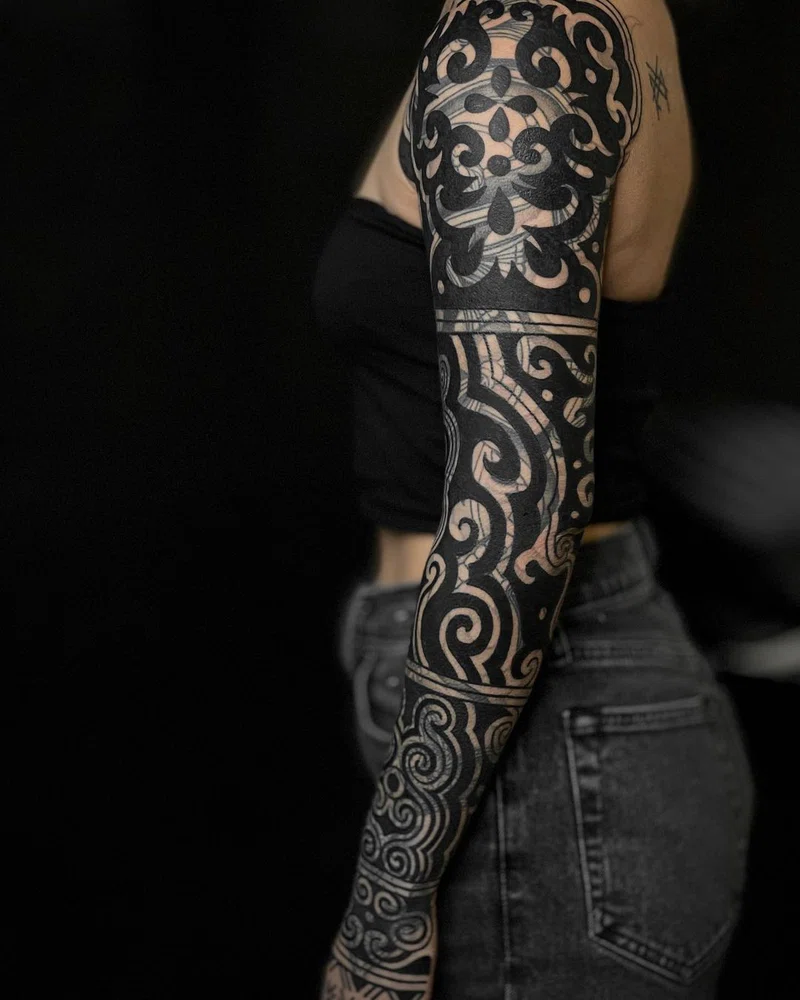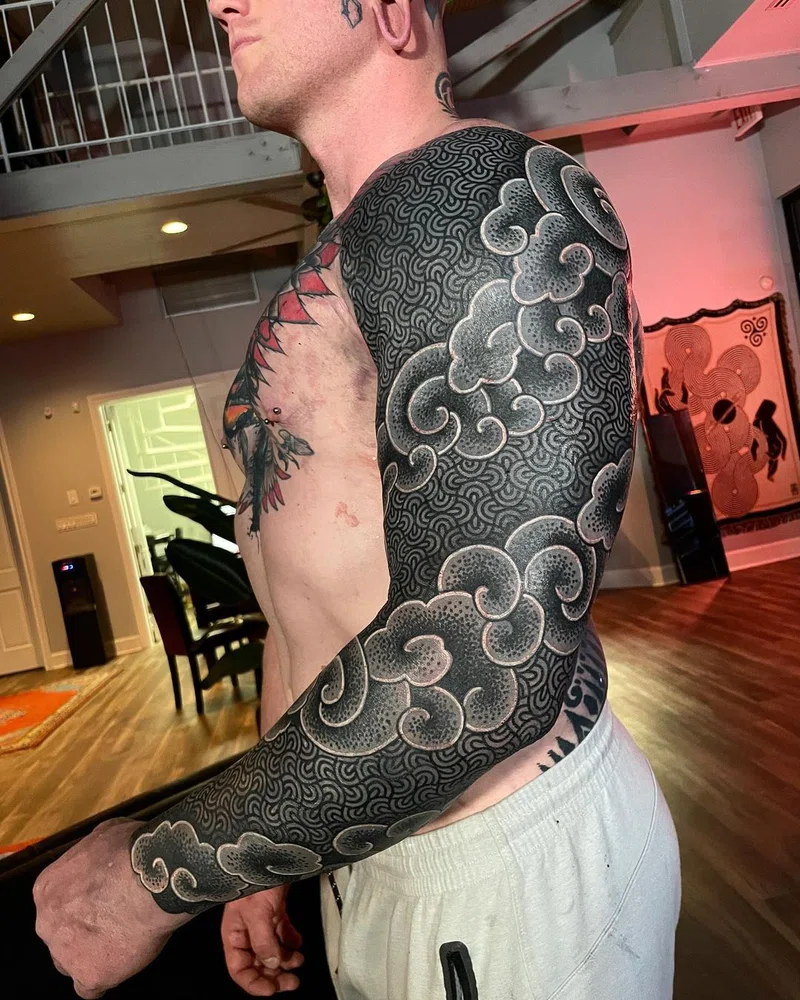How to achieve a 'blast-over' in tattoos?
Tips to partially cover old tattoos
04 January 2024
Many people are deciding to tattoo new designs over their old tattoos uniquely.
Where before a cover-up was enough, now those who are dedicated to tattooing are raising the ante a little more with blast-overs.
Do you want to know the latest trend that gives another life to tattoos? Stick around to learn how to practice it safely.
What is a blast-over?
A blast-over is a technique that has become more popular as of 2019. It is about making a tattoo on top of another, but without completely covering it.
The idea of these tattoos is not to make a cover-up, but, on the contrary, what is sought is to make both tattoos, the old and the new, work together. With this technique, old tattoos are slightly covered through layers, but where each one works perfectly separately and organically as a whole.
And to achieve this, you need to work with rather simple and synthetic designs, that is, ones that do not have many shadows, or watermarks or are overloaded with details.
The reason is as follows: the old tattoo works as a background and what is sought is for the new one to stand out and become the protagonist. If both tattoos were equally complex, you would achieve an intelligible result and in the end, neither would stand out.
This is why the blast-over technique works with thick, well-pigmented lines, as they help to achieve the effect of figure-ground effectively.
Many people confuse this technique with other similar ones such as cover-ups or blackouts, but to avoid confusion, let's make a distinction:
- Cover up: seeks to cover the tattoo completely with another tattoo.
- Blackout: You want to cover a large area with solid black, and not only the tattoo you want to cover, but also a little more.
- Blast-over: It is tattooed on top, but the old tattoo is included in the design, which works as a background.
However, as easy as it may seem to be, it is not. Designing a blast-over that works perfectly is something very complex to achieve and requires a lot of knowledge. Therefore, it is not a recommended technique for beginners.
We explain to you.
Keep in mind that you must have a lot of knowledge of composition because you have to make everything harmonious. Therefore, do not rush when designing. Take your time to try more than one possibility and talk with the client to arrive at the best option.
In addition, there is another critical point. Tattooing on already tattooed skin is a very different experience from tattooing for the first time. In some cases, they can be more swollen and red than normal, or even more prone to injury.
But don't get discouraged, a well-done blast-over can be great.
What are the benefits of blast-over?
You may wonder why anyone would choose a blast-over on a cover-up. Well, the reality is that many people no longer feel identified with their old tattoos, but often not enough to cover them completely or remove them with a laser.
This is why this technique allows for renewing the old ink and taking it to the next level. Many people do not feel comfortable with just a part of their old tattoo and, on the contrary, want to preserve some areas and colors. For this, the blast-over is ideal.

So, in summary, some benefits are:
- They allow you to reverse old tattoos that you no longer like.
- Cover areas of a tattoo that has been erased.
- Being able to improve tattoos that are poorly done.
How to make a blast-over harmonious?
For someone without experience in composition, it would be very easy to make a mistake and make the tattoo look uneven and bad. To avoid trouble, here are some tips:
- Make simple designs with thick, solid lines. Do not complicate your life by designing tattoos with many details, these do not correspond to a blast-over. Furthermore, if you do, it is very likely that the result will be a tattoo that is not understood or distinguished. Remember that a blast-over has to stand out, stand out and use the old tattoo as a background; to achieve this, simplicity and hardness in the strokes is essential.
- Studying in depth the old tattoo. Look at the areas with the highest concentration of ink and, above all, detect if there are areas where there is excess black ink. In that case, you should consider this so that the new design later "does not get lost" with the old one and can stand out much better.
- Ask the client which areas of the tattoo they like the least. This is essential to determine some limits. The client may be dissatisfied with the old tattoo in general, which benefits you because you can work more freely and any areas you cover up with the new tattoo won't be a problem. But, in the event that the client indicates that there are areas that he does or does want to cover and others that he would like to leave uncovered, he conditions the new design. Communication, dialogue, and your creativity here are fundamental.
- When designing and compositing, remember that black inks and highly pigmented colors compete. For this reason, for the new tattoo, use inks with a good concentration of color so that the lines stand out much better and take center stage. If you want to know more about which black inks to use, enter here that we leave you a list with the most used brands for tattoos with black ink in the best way.
- Bonus tip: There are people who, before having a blast-over, decide to go to some laser removal sessions to lower the intensity of the colors of the old tattoo and make the new one look much sharper. In case it is very necessary, you can talk to your client to consider this option.
Is it a good idea to blend blast-over and Blackwork?
We could say so, but be careful because not all works are equally suitable.
Just as some solid Blackwork designs could well serve to contrast something already tattooed, there are others composed mainly of lines that could also well-fit a blast over.
It all depends on how the original piece is and how it integrates the Blackwork design.
That's why we recommend that when planning the tattoo you focus your attention on the composition and harmony of the final design.
White over, another option to improve a tattoo
The white over is about making a new tattoo with white ink on a blackout.
As in the blast-over, these tattoos are simplified and highly loaded with pigment, prioritizing tattooing designs without many shadows or details.
But there is something to keep in mind, white ink is usually complex to tattoo since its dense composition makes it more difficult to penetrate the skin. We tattoo it on a solid black filler.
In addition, we told you in the article White ink tattoos, are they a good option? That these inks undergo various alterations over time, such as, for example, becoming more yellowish and erase in certain parts due to the incidence of the sun.
Tattoos made with white inks are very attractive, and in the first few days they look great, but after a few months, the situation changes. When it comes to white overs, you typically need to review the lines after a few months to set the color well and make it more consistent.
Also, with few exceptions, most blackouts are done to cover other tattoos. That's why you have to consider that under them there is an old tattoo.
Tattooing on skin overloaded with ink is complex and can directly affect the white ink. On the other hand, pricking the same area many times can even cause some type of trauma to the skin, which is why you must work cautiously, and it is not recommended for people with little experience.
Since this technique is more current in 2019, we may not be able to determine if these tattoos are well-preserved in their entirety or not.
Meanwhile, you can see the work of some professionals who have years of experience and who achieve tattoos with a high level.
The artist Jessi Manchester is an expert at this. She not only tattoos with white but works with gray and highly pigmented black lines. On most occasions, she is also in charge of doing the Blackout, but she does it with a particularity: she does not fill everything with pure black, but tattoos gray in certain areas.
In this way, the fill is not so intense, allowing you to work on top with stronger or lighter colors, making them stand out perfectly.

Another expert tattoo artist is Nathan Mould who does white over work, but in a more traditional way, without too many variations in tones or gray scales, as Jessi Manchester does.
The artist Aquarianttt achieves truly unique designs working mainly with black ink, although he occasionally makes some color combinations. This artist has collaborated with Jessi Manchester.
Or even the same Pitta Kkm He has launched into this type of work, capturing his personal style in very impressive ways.
As you can see, there are endless possibilities to create stunning blast-overs, and there is an increasing number of people who choose this alternative to give a second life to their tattoo without having to go through the laser.
Without question, this attractive style came to stay and still has a lot to offer. However, to successfully execute it without compromising both the original piece and the new one, it's necessary to have the techniques that characterize it well-learned and trained.
A great ally for this is Blackwork, since it's mainly composed of lines, solid black fillings, and high contrasts of ink and skin reserves. So, anyone who already tattoos it has a head start.
Fortunately, we have a comprehensive course entirely dedicated to this style. Curious to know more? Learn how to master one of the most versatile, flexible and demanded styles with our MasterCourse: Blackwork Tattooing, with Rebollo.